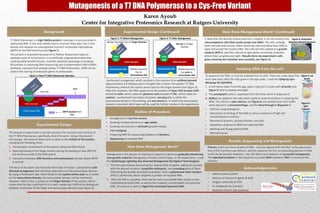
Partners in Science Final Poster
- 1. Mutagenesis of a T7 DNA Polymerase to a Cys-Free Variant Karen Ayoub Center for Integrative Proteomics Research at Rutgers University Background T7 DNA Polymerase is a high fidelity protein, meaning it is very accurate in replicating DNA. It not only initially rejects incorrect base pairs, but it also excises and replaces an unrecognized incorrect nucleoside triphosphate (dNTP) at the DNA terminus (see Figure 1). This protein is important because of its fidelity. Researchers hope to replicate some of its functions in an artificially engineered protein that could possibly benefit humans. Another potential advantage of studying this protein is improving DNA sequencing and complementary DNA (cDNA) synthesis, a process that already utilizes T7 DNA Polymerase. cDNA can be used in the cloning of eukaryotic genes in prokaryotes. Exonuclease Site Palm Domain dNTP excised from DNA DNA Poly Site Figure 1: How T7 DNA Polymerase Operates The long-term experiment in my lab concerns the structure and function of the T7 DNA Polymerase, specifically, that of its parts. Using a fluorescent microscope, the research team aims to observe the motion of the protein, including the following three: 1. Translocation (movement) of the protein along the DNA strand 2. Opening/closing of the finger domain during the binding of new dNTP to the terminus (end) of the DNA strand 3. Interaction between DNA terminus and exonuclease domain where dNTP is excised The focus of my work concerned the third type of motion. I performed a site- directed mutagenesis that will allow observation of the exonuclease domain. By using a fluorescent dye, which binds to the cystine amino acid, as a marker on the exonuclease domain, the exonuclease domain can be monitored. However, there is also a cystine on the finger domain of the protein, which means that the dye could bind to it as well, rendering it difficult to distinguish between movement of the finger and exonuclease domains (see Figure 2). Experimental Design I performed mutagenesis which resulted in the creation of an artificial plasmid (approximately 4.8 kilobase pairs in length) that contains the protein T7 DNA Polymerase, without the cystine amino acid on the finger domain (see Figure 3). After the mutation, the DNA sequence at the position of base 1541 to base 1543 should be GAA, which codes for glutamic acid (instead of TGC, which codes for cystine). I worked with two types of protein, exo plus (+), in which the exonuclease domain is functioning, and exo minus (-), in which the exonuclease domain is dormant. Both types will be used for further studies in the experiment. Exonuclease Site Palm Domain Poly Site Marker bound to Cys on Finger Domain Marker bound to Cys on Exonuclease Site Figure 2: T7 Before Mutagenesis Exonuclease Site Palm Domain Poly Site No Cys on Finger Domain Marker bound to Cys only on Exonuclease Site Figure 3: T7 After Mutagenesis 3. Now that the desired mutant plasmid is isolated, it can be inserted into ultracompetent cells (that easily accept new DNA). The cells undergo both cold and heat shocks, which stress the cells and allow their DNA to open and accept the mutant DNA. The cells are then added to a growth medium (NZY+), and then placed on agar plates containing ampicillin, where they can grow overnight. (Results form my experiment: cells grew, meaning the mutation was succesful, see Figure 4). Isolating DNA from the cells To sequence the DNA, it must be isolated from its cells. There are a few steps that must take place after the cells grow in the agar plate. I used the QIAprep Spin Miniprep Kit (QIAGEN). 1. A cell colony taken from the agar plate is placed in a tube with LB broth (see Figure 5) and incubated overnight. 2. The precipitant (cells) is separated from the fluid, which is disposed of. 3. Buffers are added to the cells which perform several functions in isolating the DNA. The cells (in a spin column, see Figure 6) are washed with each buffer when placed in a microcentrifuge, and the flow-through is disposed of. • Cell lysis using detergents • Absorption or binding of the DNA to silica in presence of high salt concentrations in column • Removal of proteins, polysaccharides, and salts • Separation of genomic DNA from plasmid DNA • Washing and drying plasmid DNA • Maintaining pH Experimental Design (Continued) Outline of Procedure • Mutagenesis to Cys-free variant • Growing mutated bacteria on agar plates • Growing cell colonies in LB broth (growth media) • DNA miniprep • Preparing DNA for sequencing (addition of primers) • Sequencing of mutated DNA How Does Mutagenesis Work? Acknowledgements • Liberty Science Center • Partners in Science Program & Staff • Rutgers University & CIPR • Dr. Sanghyuk Lee (mentor) • Matthew Putnins (lab assistant) Figure 4: Ampicillin- Resistant Mutant Bacteria How Does Mutagenesis Work? (Continued) Mutagenesis is the process of altering an organism’s genes by gradually introducing new genetic material. Mutagenesis involves several steps. In this experiment, I used the QuikChange Lightning Site-Directed Mutagenesis Kit (Agilent Technologies). 1. The first step involves denaturing the original DNA template, adding the primers with the desired mutation (ampicillin resistance), and annealing both of them (reforming the double-stranded nucleotide). Then a polymerase chain reaction (PCR) is performed, which amplifies a portion of mutated DNA. 2. After the PCR is complete, there will be some unmutated DNA, known as the methylated parental DNA, as well as the mutated, unmethylated non-parental DNA. An enzyme is used to digest the unmutated parental DNA. Figure 6: Spin Column Figure 5: LB Broth Results: Sequencing and Mutagenesis Primers, which are short strands of DNA, must be aligned with the DNA to be sequenced. One of the 7 primers was defunct, and the sequence for the corresponding portion of DNA could not be derived. However, I was still able to see evidence of successful mutagenesis. The expected mutation in the sequence occurred (GAA instead of TGC) in several of the colonies.